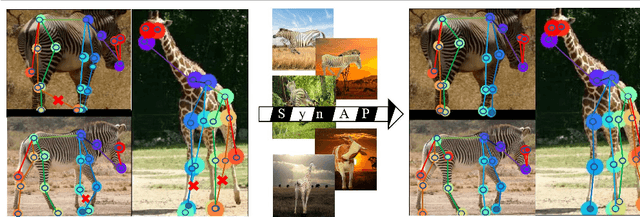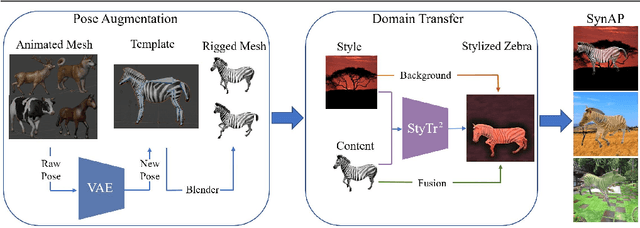Xiangyu Bai
Learning Multimodal AI Algorithms for Amplifying Limited User Input into High-dimensional Control Space
May 16, 2025Abstract:Current invasive assistive technologies are designed to infer high-dimensional motor control signals from severely paralyzed patients. However, they face significant challenges, including public acceptance, limited longevity, and barriers to commercialization. Meanwhile, noninvasive alternatives often rely on artifact-prone signals, require lengthy user training, and struggle to deliver robust high-dimensional control for dexterous tasks. To address these issues, this study introduces a novel human-centered multimodal AI approach as intelligent compensatory mechanisms for lost motor functions that could potentially enable patients with severe paralysis to control high-dimensional assistive devices, such as dexterous robotic arms, using limited and noninvasive inputs. In contrast to the current state-of-the-art (SoTA) noninvasive approaches, our context-aware, multimodal shared-autonomy framework integrates deep reinforcement learning algorithms to blend limited low-dimensional user input with real-time environmental perception, enabling adaptive, dynamic, and intelligent interpretation of human intent for complex dexterous manipulation tasks, such as pick-and-place. The results from our ARAS (Adaptive Reinforcement learning for Amplification of limited inputs in Shared autonomy) trained with synthetic users over 50,000 computer simulation episodes demonstrated the first successful implementation of the proposed closed-loop human-in-the-loop paradigm, outperforming the SoTA shared autonomy algorithms. Following a zero-shot sim-to-real transfer, ARAS was evaluated on 23 human subjects, demonstrating high accuracy in dynamic intent detection and smooth, stable 3D trajectory control for dexterous pick-and-place tasks. ARAS user study achieved a high task success rate of 92.88%, with short completion times comparable to those of SoTA invasive assistive technologies.
STREAMS: An Assistive Multimodal AI Framework for Empowering Biosignal Based Robotic Controls
Oct 04, 2024



Abstract:End-effector based assistive robots face persistent challenges in generating smooth and robust trajectories when controlled by human's noisy and unreliable biosignals such as muscle activities and brainwaves. The produced endpoint trajectories are often jerky and imprecise to perform complex tasks such as stable robotic grasping. We propose STREAMS (Self-Training Robotic End-to-end Adaptive Multimodal Shared autonomy) as a novel framework leveraged deep reinforcement learning to tackle this challenge in biosignal based robotic control systems. STREAMS blends environmental information and synthetic user input into a Deep Q Learning Network (DQN) pipeline for an interactive end-to-end and self-training mechanism to produce smooth trajectories for the control of end-effector based robots. The proposed framework achieved a high-performance record of 98% in simulation with dynamic target estimation and acquisition without any pre-existing datasets. As a zero-shot sim-to-real user study with five participants controlling a physical robotic arm with noisy head movements, STREAMS (as an assistive mode) demonstrated significant improvements in trajectory stabilization, user satisfaction, and task performance reported as a success rate of 83% compared to manual mode which was 44% without any task support. STREAMS seeks to improve biosignal based assistive robotic controls by offering an interactive, end-to-end solution that stabilizes end-effector trajectories, enhancing task performance and accuracy.
Temporal-controlled Frame Swap for Generating High-Fidelity Stereo Driving Data for Autonomy Analysis
Jun 12, 2023Abstract:This paper presents a novel approach, TeFS (Temporal-controlled Frame Swap), to generate synthetic stereo driving data for visual simultaneous localization and mapping (vSLAM) tasks. TeFS is designed to overcome the lack of native stereo vision support in commercial driving simulators, and we demonstrate its effectiveness using Grand Theft Auto V (GTA V), a high-budget open-world video game engine. We introduce GTAV-TeFS, the first large-scale GTA V stereo-driving dataset, containing over 88,000 high-resolution stereo RGB image pairs, along with temporal information, GPS coordinates, camera poses, and full-resolution dense depth maps. GTAV-TeFS offers several advantages over other synthetic stereo datasets and enables the evaluation and enhancement of state-of-the-art stereo vSLAM models under GTA V's environment. We validate the quality of the stereo data collected using TeFS by conducting a comparative analysis with the conventional dual-viewport data using an open-source simulator. We also benchmark various vSLAM models using the challenging-case comparison groups included in GTAV-TeFS, revealing the distinct advantages and limitations inherent to each model. The goal of our work is to bring more high-fidelity stereo data from commercial-grade game simulators into the research domain and push the boundary of vSLAM models.
Bridging the Domain Gap between Synthetic and Real-World Data for Autonomous Driving
Jun 05, 2023Abstract:Modern autonomous systems require extensive testing to ensure reliability and build trust in ground vehicles. However, testing these systems in the real-world is challenging due to the lack of large and diverse datasets, especially in edge cases. Therefore, simulations are necessary for their development and evaluation. However, existing open-source simulators often exhibit a significant gap between synthetic and real-world domains, leading to deteriorated mobility performance and reduced platform reliability when using simulation data. To address this issue, our Scoping Autonomous Vehicle Simulation (SAVeS) platform benchmarks the performance of simulated environments for autonomous ground vehicle testing between synthetic and real-world domains. Our platform aims to quantify the domain gap and enable researchers to develop and test autonomous systems in a controlled environment. Additionally, we propose using domain adaptation technologies to address the domain gap between synthetic and real-world data with our SAVeS$^+$ extension. Our results demonstrate that SAVeS$^+$ is effective in helping to close the gap between synthetic and real-world domains and yields comparable performance for models trained with processed synthetic datasets to those trained on real-world datasets of same scale. This paper highlights our efforts to quantify and address the domain gap between synthetic and real-world data for autonomy simulation. By enabling researchers to develop and test autonomous systems in a controlled environment, we hope to bring autonomy simulation one step closer to realization.
Prior-Aware Synthetic Data to the Rescue: Animal Pose Estimation with Very Limited Real Data
Aug 30, 2022



Abstract:Accurately annotated image datasets are essential components for studying animal behaviors from their poses. Compared to the number of species we know and may exist, the existing labeled pose datasets cover only a small portion of them, while building comprehensive large-scale datasets is prohibitively expensive. Here, we present a very data efficient strategy targeted for pose estimation in quadrupeds that requires only a small amount of real images from the target animal. It is confirmed that fine-tuning a backbone network with pretrained weights on generic image datasets such as ImageNet can mitigate the high demand for target animal pose data and shorten the training time by learning the the prior knowledge of object segmentation and keypoint estimation in advance. However, when faced with serious data scarcity (i.e., $<10^2$ real images), the model performance stays unsatisfactory, particularly for limbs with considerable flexibility and several comparable parts. We therefore introduce a prior-aware synthetic animal data generation pipeline called PASyn to augment the animal pose data essential for robust pose estimation. PASyn generates a probabilistically-valid synthetic pose dataset, SynAP, through training a variational generative model on several animated 3D animal models. In addition, a style transfer strategy is utilized to blend the synthetic animal image into the real backgrounds. We evaluate the improvement made by our approach with three popular backbone networks and test their pose estimation accuracy on publicly available animal pose images as well as collected from real animals in a zoo.
 Add to Chrome
Add to Chrome Add to Firefox
Add to Firefox Add to Edge
Add to Edge